Overall, Nathan has been a healthy kid.
Unlike many kids with Down syndrome, he has never had any heart problems, GI issues, a wacky thyroid, problems with his hearing or vision, or recurring respiratory infections. In fact, although I haven’t officially tracked it, I’m pretty confident that I – the marathon runner – have been sick more than he has in these past three years. When everything’s going our way health-wise, it’s easy to forget that things may not always be that way.
Nathan first ran a fever on Sunday, February 17.
It was easily controlled with Tylenol and he didn’t have any other serious symptoms, so I didn’t rush him off to the doctor on Monday morning. By Tuesday morning, however, he was lying face down in his chair so we packed up and headed out. The doctor test him for RSV, flu, strep throat, checked his ears, and did a chest X-ray to look for pneumonia. All came up negative, so he got a hit of antibiotics and steroids and a script for an oral antibiotic. He improved, but very slowly, until we thought he’d finally broken through the following Monday.
On Tuesday, I sent him back to preschool, sure he’d turned the corner. An hour and a half after I dropped him off, his teacher texted me that he laying down on the ground on the playground. By the time I picked him up, his temperature was back up to 101. Off we went to the doctor. Diagnosis: pneumonia and an ear infection. A shot of Rocephin. Another oral script. Come back tomorrow.
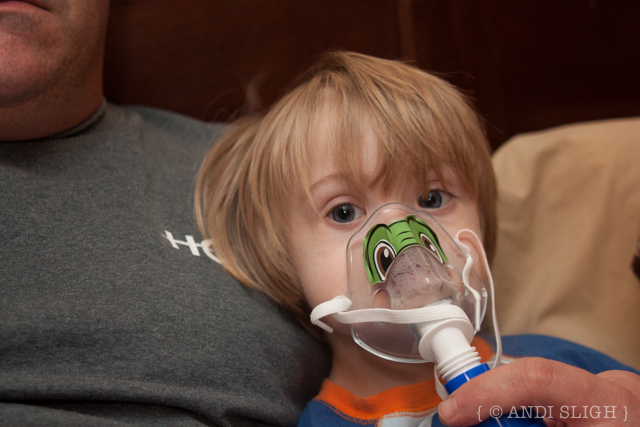
On Wednesday, we returned to the doctor. Another shot of Rocephin. A nebulizer and a box of albuterol. Keep up the oral antibiotics. Come back next week.
Once again, Nathan improved, but slowly.
On Wednesday, the day before he was to return to the doctor, we were confident he was kicking the bug. The morning of the appointment, however, his fever spiked again. A different oral antibiotic this time – our third oral in as many weeks – and come back tomorrow.

When we returned on Friday, he was worse, not better. His doctor decided it was time to admit him to the hospital – his oxygen saturation levels were B-A-D bad. She also decided that he needed to be tested for something else: leukemia. She didn’t say it outright, and I didn’t say it, either, but we were both thinking it. He had always been healthy; why was he having so much trouble kicking this bug?
We breathed a sigh of relief later that afternoon when his results came back negative and he came up positive for mycoplasma pneumonia. That was treatable! He’d already been treated for it with his second round of antibiotics, but maybe that just wasn’t enough. Surely now that the Really Bad Thing had been ruled out, some IV antibiotics, oxygen through a cannula, and some more targeted medical care would knock it out in a couple of days!
Except that it didn’t – at least not as quickly as we had hoped. His sat level dropped during the night to a concerning level, indicating he could have sleep apnea. There was talk of transferring him to a children’s hospital, but mostly we just waited to see.
Saturday came and went.
Sunday came and went.
Monday came and went.
With each new day, he was getting better. He began eating more, he became more active, and his fever didn’t return. But his sat kept dropping while he slept, and he couldn’t break free of the oxygen even when he was awake. The doctor began to worry again, and ordered a new round of chest X-rays and and an echocardiogram. Both were clear.
Tuesday came and went.
On Wednesday, Nathan came off the oxygen and did well. The real test, though, would be what happened when he fell asleep. Shortly after lunch, he drifted off and slept soundly for about three hours. The oxygen remained off and he held his own.
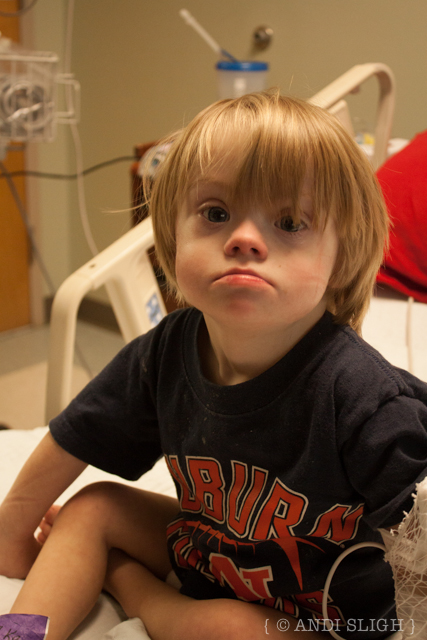
The doctor came by in the afternoon and we spoke at length about Nathan’s situation. She had been consulting with (at least) two other pediatricians for several days, and had spoken with another doctor in the pulmonology department at Children’s Hospital up in Birmingham that day. That doctor told her about a very similar case they had seen about a year ago – same age, same progression, and the child also had Down syndrome. Eventually the child recovered, but the mystery of Why was never resolved.
It was a reminder to both of us that Nathan doesn’t fit the standard textbooks – no one with Down syndrome does. A different textbook exists for people with Down syndrome, and unlike the standard textbook, it isn’t updated regularly with the latest and greatest research. Sometimes the typical approaches just don’t work.
But Nathan doesn’t fit the Down syndrome textbook, either.
He doesn’t fit because his form of Down syndrome – mosaic Down syndrome – puts him a tiny subset (less than 3%) of the T21 population. Research on T21 is sparse; studies related to mosaic Down syndrome are virtually non-existent. There is no textbook for him.

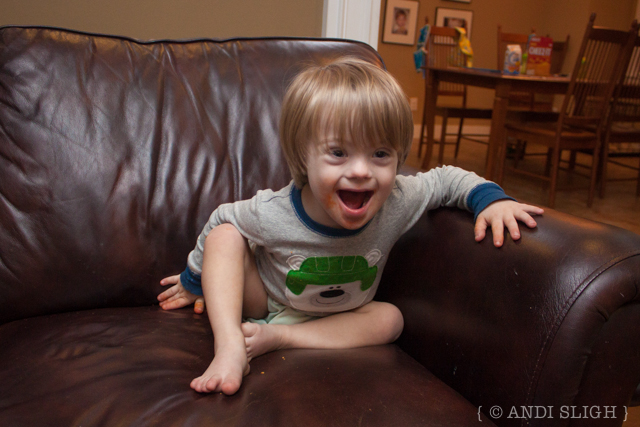
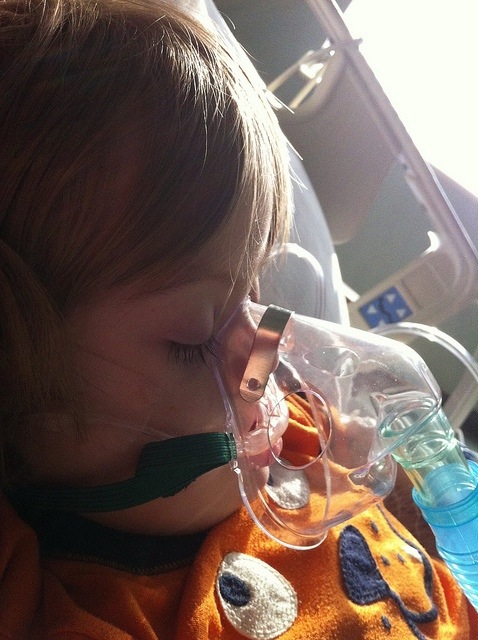
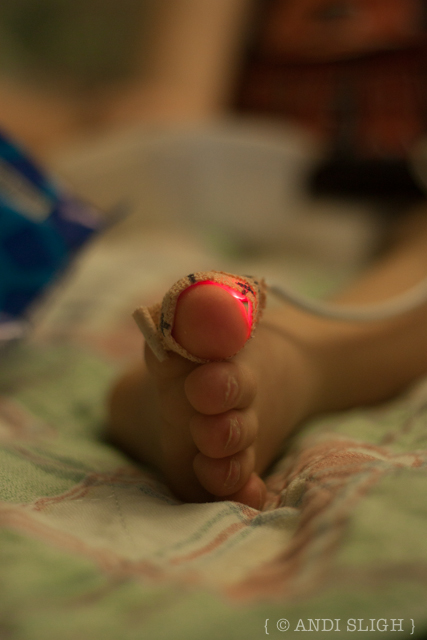
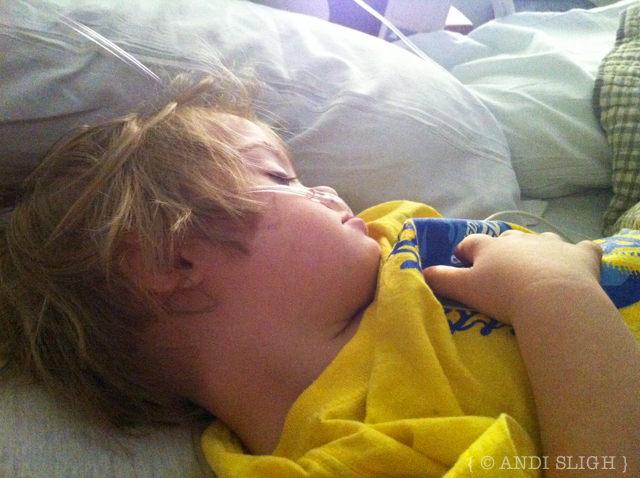

I think the problem with textbooks is that when it comes to people they can only be broad guides, not as absolutes. Dev is plain jane t-21, but she also has been very healthy, with out heart, spine, intestine….anomalies (thanks be to G-d). She always “surprises” someone with her ability in this or that as it is unexpected. But, when I think about it, it is the same for our “typical” kids. I think that is the blessings of having more than one child, you start to realize they are ALL unique, a-typical, special, VALUABLE in their own way, not to be categorized just because of a Dx, race, gender, religion…
Be blessed with both of your wonders.
PS, so glad that Leukemia did not raise it’s head, I was so scared at the beginning of the post….
Not as scared as I was when it was happening! 😉 But in all seriousness, the scariest part of it all for me was not knowing that the doctor wanted to test for leukemia, but seeing the fear in her eyes when I knew it was true. She didn’t have to say it because I knew what she was thinking.
i don’t know if you know aimee from aimee’s bowl of cherries, but her daughter has had two hospital stays with oxygen. they are not sure why things have hit her so hard and why it’s taken so long for her to recover. they are keeping her home from school for another week to make sure she is completely healthy. rachel, who was the healthiest girl until preschool, also seems to take twice as long to recover from things but it’s probably because we’ve been hit over and over again with RSV, croup, bronchiolitis, etc. i think our kids do not revel just how sick they are. i have to keep a close eye on rachel because she can happily play through a fever and cough unlike my son who screams bloody murder when a nostril is blocked! 🙂
You make an excellent point, Maggie, and that’s something I pointed out to the doctor last week. Not sure if you’ve ever had a cat, but I have had both cats and dogs and I told the doctor that Nathan is like a cat. By the time you realize he’s sick, he’s very very sick. I’m not certain if it’s a high tolerance for pain, some innate tendency (possibly related to the extra chromosome?) to “hide” pain and discomfort, or something else altogether, but hide it he does.
Did they test his thyroid function? Was Endocrine ever consulted? If something is out of whack there, it will impact his ability to heal.
Yep. Since his illness coincided with his third birthday, they were going to be checking all of that, anyway, so they went ahead and did it. All clear.
So sorry to hear about Nathan’s tough time kicking this very tough bug but soooo very glad to hear that he is back at home with his family. We had a similar experience with our son Jack when he was about 2 years old. He ended up having a modified sleep study done (they called it more of a “nap” study) at a Children’s Hospital and determined that the drop in O2 sats was related to sleep apnea. They said that it is more common with T21 because of the lower muscle tone. His sats didn’t drop to the point where it was a concern as long as he is healthy but something to watch at more closely when he is sick…hope this info might be helpful.
A sleep study is our next step – what you described sounds very much like what is going on with Nathan, and would certainly explain why his body was having a hard time kicking the bug. The body repairs itself why while we sleep, so the sleep apnea could very easily have been hindering that repair.
Hi, what an ordeal! I am sorry to say, but unwittingly you did something that made his illness a bit worse. Tylenol is awful for our kids – depletes glutathione and lowers immunity even worse. I suspect there is an awful lot about the cellular mechanisms of DS most moms don’t know….I learned on some amazing lists, and am treating my kid. She had no chest colds for 2 winters now. Groups.yahoo.com/group/DSTNI and w w w dot einstein-syndrome.com/join
Liora, do you have links to any medical studies with this information? You’ve made me curious.
Oh, and honey, the next time you want to tell another mom that you think she “unwittingly” made her baby sicker, you may want to do it in a private message.
I see that Dawn has already responded to your comment, Liora, but I will, as well. First off – I actually misspoke in my post. I didn’t give him Tylenol, I gave him Motrin (Tylenol is what I normally take myself, though I have on one or two occasions stacked it with Motrin when treating the kids under extreme circumstances and with the advice of our physician). You may have concerns with Motrin, as well, but if a child runs a fever in excess of 101 degrees for several days in a row, the dangers of the fever outweigh the risks of the Motrin. I do not medicate myself or my children unnecessarily, because I know that EVERY medication has the potential for negative effects on the body, but I also know that sometimes that tradeoff is worth the risk. An extreme example is chemotherapy – there is no doubt that its effects are potentially deadly, but when the choices are certain death or possible death, cancer patients will choose chemo most of the time.
I appreciate that you are trying to be helpful, but since this blog is my home (and therefore follows my rules), I will ask that in the future you choose your words more carefully. I’m always open to learning new things, but wholesale statements about something that I or another commenter did which are as of yet unproven by research are not appropriate here. Feel free to share links to information that other readers may be interested in, but don’t make pronouncements about the validity of anyone’s treatment choices when the evidence is still very much up in the air. Instead of saying “you did something that made his illness a bit worse” you could phrased it as “have you seen that some studies suggest that Tylenol actually lowers immunity?” Not only is that statement less offensive to the parent who is doing the best they can for their child, but it also is less abrasive and therefore more likely to pique the interest of anyone who reads it. Many mothers of children with disabilities struggle with the feeling that if they had done something differently their child would not have that disability – in most cases, it’s a completely irrational guilt, but that doesn’t make it any less painful. When people leave comments like yours, it fuels that destructive fire that mothers are to blame when their children suffer.
The bottom line (which was the whole point of this post) is that the human body is very complex and therefore much is still unknown about how it works – much less is known about the body dynamics of people with an extra chromosome, and even less about those with a mosaic chromosomal makeup.